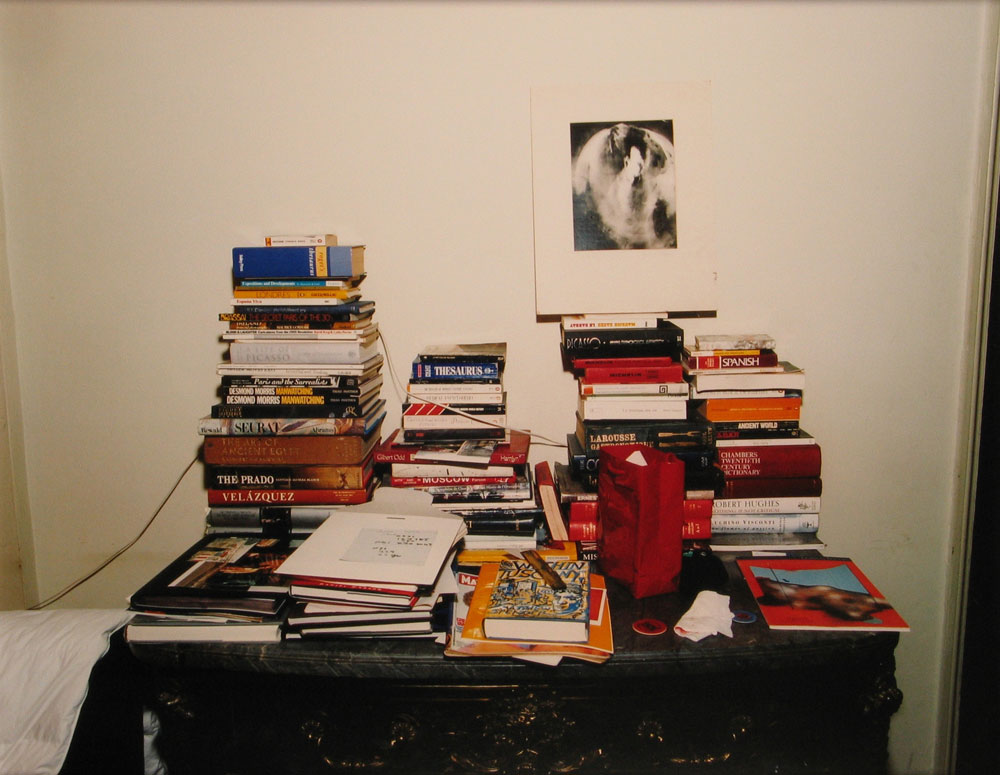Bacon's Books: Francis Bacon's library and its role in his art

This project is supported by the IRCHSS under Strand 5: Targeted Co-Fund Initiatives.
Principle Investigator: Dr Yvonne Scott
Associate investigator: Prof Nicolas Grene
Co-Fund Partner: Barbara Dawson, Dublin City Gallery, the Hugh Lane
Research Assistant: Dr Monika Keska
Bacon's Books database (annotated) (.xls file, 350kb)
This IRCHSS-funded project is a collaboration between the History of Art Department and Dublin City Gallery, the Hugh Lane. DCGHL holds a donation of around one thousand publications that belonged to the artist Francis Bacon at the time of his death.
This project will catalogue the books into a detailed searchable database for visiting researchers, with a list of texts to be made available online.
A symposium to present papers analyzing the relationship between Bacon's literary interests and his art, is planned for October 2012, and a call for papers has been issued.
The project leaders are Dr Yvonne Scott (PI), History of Art Department, Trinity College Dublin and Barbara Dawson, Director of the DCGHL. Prof Nicolas Grene, Department of English, TCD is a Research Associate to the project, and Dr Monika Keska has been appointed Research Assistant. Dr. Margarita Cappock (Head of collections, DCGHL) is also a key member of the research team.
Bacon's Books: outline of the project
The personal library of an artist is widely recognised as an invaluable resource for exploring and understanding their work. This project is devoted to cataloguing and analysing the library of internationally-acclaimed, Dublin-born artist, Francis Bacon (1909-1992), whose estate includes c.1,000 books. Donated to Dublin City Gallery, the Hugh Lane, Ireland's first museum dedicated to Modern art, the Francis Bacon library represents an invaluable, but so far under-exploited resource for illuminating the imagery of this towering figure of twentieth-century visual expression.
Artist's libraries provide an invaluable insight into: (i) the latent interests that stimulate the acquisition of selected books in the first place (ii) book illustrations that inform or influence the artist's approach to imagery, and (iii) potential sources of intellectual inspiration that may emerge in the work.
Bacon read voraciously and his range of interests is evident in the numerous books on subjects as diverse as art, photography, history, politics, philosophy, cinema, sport, supernatural phenomena, and medical textbooks. As well as drawing on visual imagery, Bacon explored literary sources for inspiration. His profound interest in poetry and prose of classic authors included T.S. Eliot, Aeschylus, Shakespeare, Federico Garcia Lorca and W.B. Yeats. The significance of certain themes is indicated by the numbers of books in identifiable fields, and many also have glosses and notes, paint accretions, pages removed and maintained, for reference.
These books, and relevant aspects of their condition, have never been fully catalogued, and - most significantly - no comprehensive analysis to examine the relationship between text and image in the work of this artist has yet been undertaken.
Initiated in the year that Dublin has been recognised and honoured as a Unesco City of Literature, this project will facilitate an examination of the dynamic relationship between verbal and visual texts, in the work of this major Irish artist.
Aims and objectives
The aim of the project is to digitally catalogue the collection of c.1,000 texts owned by Francis Bacon at his death, donated to the Dublin City Gallery, the Hugh Lane (DCGHL). Using a recognised, appropriate digital database - TMS (The Museum System database) -the collected material will provide a research resource that will promote a more informed and nuanced understanding of the artist's imagery.
This will be achieved by performing searches and groupings on the database material, in order to develop a 'map' of the fields of interest according to identified variables: the genres of the texts, the types of theme addressed, the regions encompassed, the time periods explored, the imagery projected, the media exploited, and other fields as identified within the scope of the book collection.
The database will also include the digital scanning of book covers, and those pages in the texts that are marked with the artist's notations, paint accretions, and heavy usage/wear.
Where appropriate, paintings that are known to relate directly to texts in Bacon's library, either through their titles, or other indication will be noted. This element however will represent an ongoing process of accretion that will continue beyond the scope of the present project.
In addition to the detailed database, an abridged version, listing all texts by author, title, publisher, location and date will be made accessible online via websites at Trinity College and the Dublin City Gallery, The Hugh Lane, to facilitate wide international access for initial searches. If feasible, the full version of the database will be made accessible on the web. This resource can be expected to: facilitate research, attract researchers to Ireland, and inform the public.
An overview analysis, of the patterns of concentration indicated by the numbers of texts, will summarise and quantify Bacon's apparent areas of interest for further evaluation. The analysis will be directed to facilitate appropriate and judicious use of an invaluable research resource to fuel ongoing, and further projects, not only by the participants in the project, but by myriad other researchers interested in Francis Bacon, into the future.

